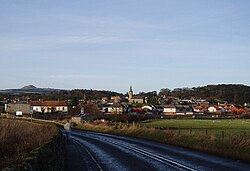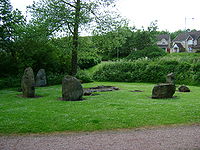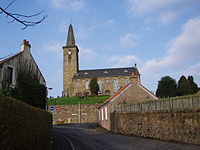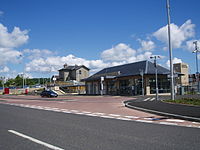Markinch
| Markinch | |
| Fife | |
|---|---|
 Markinch from the south | |
| Location | |
| Grid reference: | NO296016 |
| Location: | 56°12’9"N, 3°8’6"W |
| Data | |
| Population: | 2,420 (2008 est.) |
| Post town: | Glenrothes |
| Postcode: | KY7 |
| Dialling code: | 01592 |
| Local Government | |
| Council: | Fife |
| Parliamentary constituency: |
Glenrothes |
Markinch is a small town in the heart of Fife. According to an estimate taken in 2008, the town has a population of 2,420. Markinch sits immediately east of Glenrothes.
History

Much of the early history of the town is unknown. The earliest record of a settlement is Balfarg stone circle, in an area now incorporated into the new town of Glenrothes, which is said to date back to 3,000BC from the Neolithic period.[1][2] Under the original name of Dalgynch, the town is believed by some to have served as the Pictish capital of Fife.[2] Terraces on Markinch Hill are thought to be either mediæval or Roman in origin and on the northern outskirts of the town beside the East Lodge of Balbirnie House stands the ancient Celtic Stob Cross which may have marked the limits of sanctuary of Markinch Church.
The town is built on the top and sides of a low ridge, which, according to tradition, was once an island in a lake. This is supposed to explain the derivation of the name Markinch. The height of this ridge is greater at its northern and southern extremities than at the centre. The northern was at one time occupied by a Culdee cell; and the southern, known as Markinch Hill, has six terraces, each 20 feet broad, and rising one above the other, cut out from it. By some, these terraces have been ascribed to the Romans, while others have thought it probable that they were intended for an amphitheatre, from which games, etc., engaged in below, might easily be viewed. It is now hardly possible to make out the terraces, owing to the ridge being overgrown with trees, planted by the late General Balfour. When the parish church was built is unknown; it was, however, enlarged and repaired in 1806, and has now 1050 sittings. The Free church was renovated, and two stained-glass windows were inserted, in 1883; and there was also a U.P. church.
During the industrial revolution in the middle of the 19th century, the village started to adapt to spinning and weaving production. The use of water wheels of the corn and meal mills encouraged new industries to begin along the River Leven on land between Auchmuty (now part of Glenrothes) and Milton of Balgonie in the form of paper mills, bleach mills and ironworks.[1] Papermaking was an important local employer based on the town's close proximity to the River Leven, until one of the two paper mills in the town, Sappi Graphics, closed down a few years ago. The Tullis Russell paper mill, however, is still in operation with a 600 strong labour workforce. Markinch's former Haig's Whisky bottling plant is now used as a business park and is split into small units. This is where Fife radio station Kingdom FM is based. Haig's used to be a major employer in the town and many local residents still have connections with the firm, now absorbed into Diageo.
Parish church

The parish church, prominently situated on a mound at the highest point of the town, and dedicated to the Pictish St Drostan, is recorded in documents from the 11th century on, though it may well be of earlier origin.
Though the body of the church is a plain Georgian 'preaching box' of 1786, the adjoining tower is mediæval, and may date to the late 11th-early 12th centuries. Of exceptionally fine masonry, it is very similar to the tower of St. Rule's Church in St Andrews, and may be a copy of it on a smaller scale. It is crowned by a rather incongruous small Classical spire added in 1807.
Sports and recreation
The town enjoys a range of local facilities including football, bowling, tennis, Markinch Curling Club, and parks. Markinch's park is dedicated to Provost John Dixon who presented it to the burgh in 1919. The much larger Balbirnie Park, formerly the property of the Balfour family, lies nearby to the northeast. The park includes a golf course, Balbirnie House Hotel, formerly the Balfour family's home and subsequently the headquarters of Glenrothes Development Corporation, before its latest reincarnation, and craft centre.
The popular Markinch Highland Games are held in John Dixon park.
Transport

Markinch has good transport links being well linked to Dundee, Aberdeen and Edinburgh by rail. Markinch Interchange lies on the Edinburgh to Aberdeen Line connecting Perth and Inverness, the latter by way of the Highland railway line. The station has recently been upgraded with a new station building, longer platforms, and park and ride facilities. Regular bus services link the station with Glenrothes and Leven Town Centres.
The station was once a terminus of a branch line, which ran through the land now occupied by Glenrothes between Leslie and Markinch. The line was closed to passengers in 1935, but remained open to freight until 1967. The former branch line now forms part of the Fife Cycle Network and has been named Böblingen Way, after Glenrothes' German Twin Town. Another section of the branch line which linked to Tullis Russell paper mill was still in use until the early 1990s, but this has now also been removed and converted into a cycleway linking to Glenrothes.
Outside links
- Markinch on FifeDirect
- Its entry in the Gazetteer for Scotland
- Information on Markinch from GENUKI
- Markinch Scouts website
- Markinch Heritage Group Web site
- Markinch Parish Church website
- Markinch Amateur Operatic Society website